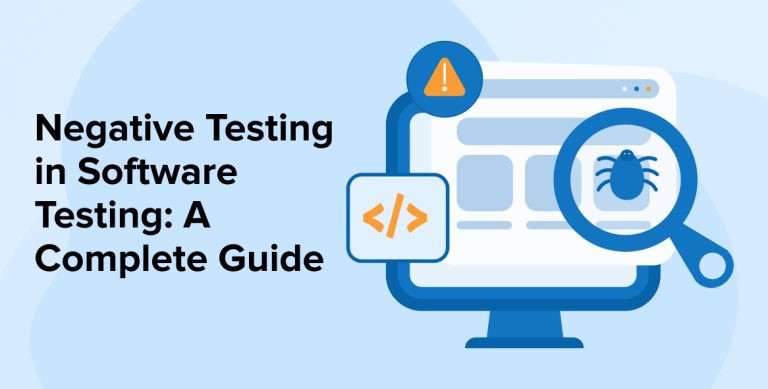
Software testing is important for making sure a program is functioning correctly. Experts who work in a software testing company can perform a wide range of testing tasks. These tests can be categorized into two classifications–Positive testing and negative testing.
Positive testing is more common than negative testing in software testing, yet both are equally essential. Testing whether an application performs as expected is known as positive software testing, and most testers are aware of this. However, many underestimate the value of negative testing. Hence, in this blog, we will understand what negative testing is, its purpose, and its benefits.
1. What is Negative Testing?

Negative testing is a type of software testing that involves testing random input data and identifying issues within the program. The purpose of negative testing is to verify that the product or program won’t crash or act strangely if the user enters any kind of unexpected or invalid input. It is also known as failure testing or error path testing.
In contrast to the wide use of positive methods such as unit testing, integration, system, acceptance, regression, and smoke testing many enterprises fail to address negative testing properly. The goal here is to find any errors, vulnerabilities, or defects in a system or program by intentionally feeding it unexpected or inaccurate data.
2. Purpose of Negative Testing
In the software development process, negative testing is a quality control approach that ensures full test coverage. The purpose of negative testing is to observe how the software behaves when subjected to unexpected input.
In this approach, a developer or tester makes a system more stable and dependable by intentionally trying to crash it or by exploiting inaccurate information to find unexpected errors.
Here is a summary of many purposes of negative testing:
- Testing the application’s response via unexpected inputs.
- Negative testing is carried out to improve the application’s quality.
- It assists in finding and resolving stability problems that positive testing would not have identified.
3. Benefits of Negative Testing
Some of the many benefits of using negative testing include:
3.1 Providing an Excellent Application
Providing clients with reliable and robust software solutions is a company’s responsibility. Companies can boost the overall quality of their software applications by identifying potential weaknesses and vulnerabilities through negative testing.
3.2 Assists in Bug Processing
To avoid application failures caused by inaccurate bug processing, negative testing is useful for confirming whether the software code ceases to handle a designed use case properly.
3.3 Clean Test Data
Testing with invalid data can assist in identifying the difference between valid and invalid data. This process allows for necessary updates before removing the invalid data from the project database.
3.4 Locate Potential Security Issues
When testing software, it’s important to make sure that users cannot access personal accounts unless authorized by the business. One way to achieve this is through negative testing. This approach allows you to block a certain set of users from accessing the app’s more advanced features.
3.5 Enhanced Overall Efficiency
If the program or system isn’t reliable enough, negative testing helps make it more user-friendly. It should be considered before the product is released to the public.
3.6 Preventing Failure
Making sure that software programs are completely bug-free is an incredibly tough task. But it’s equally important to make sure the app works properly once it’s out there. Negative testing is essential for identifying potential weak spots and reducing risk.
4. Techniques to Perform Negative Testing
One of the most important parts of software testing is negative testing, which checks how the system responds to incorrect or unexpected inputs. To find bugs, security holes, and other issues with the software program, this type of testing is essential. To carry out accurate negative testing, a variety of techniques are used, such as:
4.1 Boundary Value Analysis:
This method is based on checking the limits or extreme values of input parameters. Its goal is to test the system’s behavior at the lower and higher boundaries, making sure it handles values appropriately within and outside of those ranges.
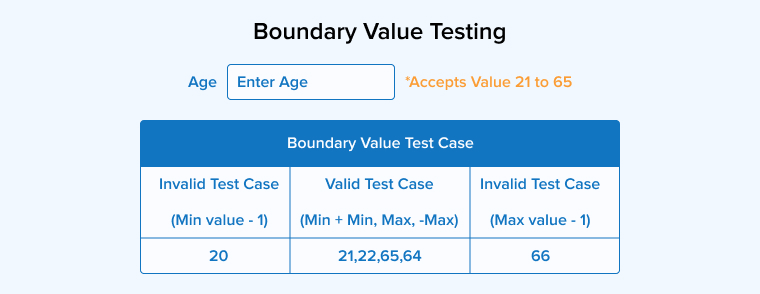
Here is what Quora User says about Boundary Value Analysis

4.2 Equivalence Partitioning
The input values are divided into several parts, and a portion of each partition is tested using this method. For instance, if the text field holds values between 1 and 50 characters, the respective segments will be 0 to 1, 1 to 50, and 50 to 100.
One way to test an app’s functioning is via equivalence partitioning, a type of black-box testing. It reduces the number of test cases needed without affecting the application’s functioning.
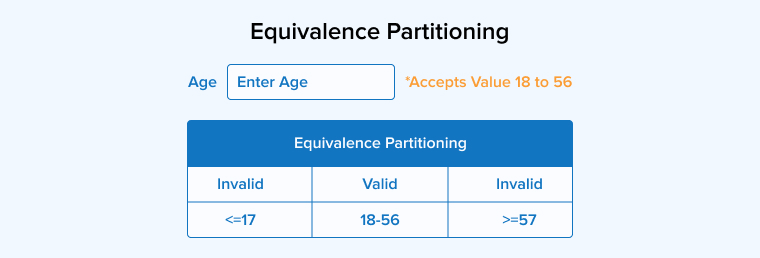
4.3 Error Guessing
This process identifies the exact reasons for error messages or failures. It is important to find and fix the problem without causing the system to crash is usually preferable. However, if an error condition is not quickly identified and corrected, it may sometimes lead to a severe downstream failure.
4.4 Checklists
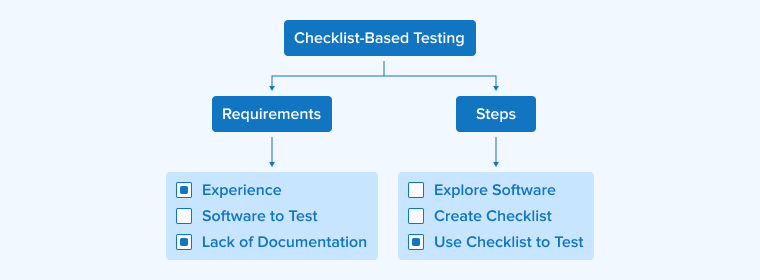
By describing possible error conditions, test conditions, and test cases, checklists provide a structured approach to negative testing. They assist in making sure that testers cover every aspect by reminding them to do so.
4.5 Anti-patterns
Software bugs can be introduced via anti-patterns, which are fundamental designs that may seem reasonable but result in execution behaviors causing these errors. If you want a flawless system, you have to identify and validate these patterns. Making your system more resilient is another benefit of removing anti-patterns.
4.6 Fuzz Testing

To test how a product works, software testers fill up the app/system fields with random data and then submit the data. Analyzing these results can help identify patterns in issues that can lead to errors and crashes.
Here is what Halborn tweeted about Fuzz Testing
2/ Fuzzing or Fuzz Testing is an automated testing technique (once the fuzzing harness has been created) used to discover potential vulnerabilities or issues in a program by feeding it with vast amounts of random, semi-random, or invalid data. 📑
— Halborn (@HalbornSecurity) April 18, 2023
4.7 Exploratory Testing
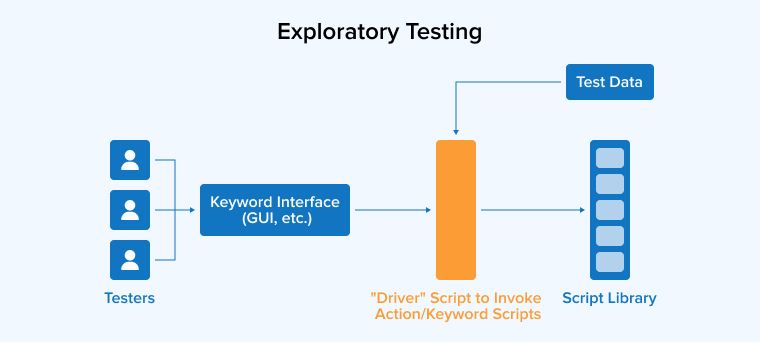
It is possible to conduct exploratory testing by generating and executing test cases concurrently. To uncover bugs, testers use this method to interact with software applications through the use of test cases and a variety of inputs. The purpose of exploratory testing is to determine if the potential issues discovered by running the previously created test cases are true or false.
4.8 State Transition Testing
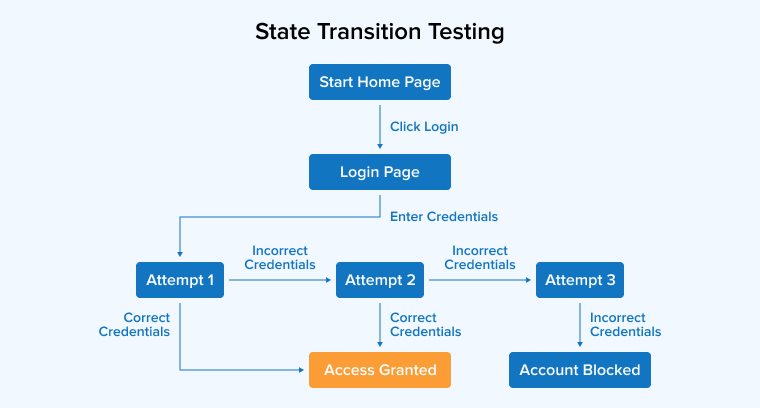
Finding bugs in the program is the goal of this method. It comes from the idea that software can only be in one state at a time. When no issues are detected, the software is said to be running smoothly.
Here is what Nikita Shpilevoy tweeted about State Transition Testing
State Transition Testing: This technique is applied to programs that have specific states and transitions between them. It's a necessary practice for online stores, exchanges, and other applications that involve entities like "orders."
— Nikita Shpilevoy (@nickshpil) November 2, 2023
/8
5. How to Perform Negative Testing?
All negative test scenarios must be considered to execute a negative test. When doing a negative test, it is essential to analyze each test scenario independently and determine the correct way to apply it.
Performing a negative test involves the following steps:
- The planned negative test scenarios need to be reviewed and evaluated first. It is crucial to include test scenarios linked with security vulnerabilities, incorrect inputs, and other possible concerns in test cases.
- The next step is to create fake inputs for testing software. Two types of tools can be used for this: manual and automatic. But remember that automated testing techniques are better since they can simulate a wide range of negative test cases that would be hard to do manually.
- After conducting the negative tests, monitor the program closely to observe its behavior. Note if any unexpected or undesirable results, errors, crashes, or vulnerabilities are found.
- To identify any problems or errors uncovered during the previous test, you have to review the outcome after the negative test has been executed. By putting the program through tests in a challenging environment, you can find out more about its behavior and performance. On this basis, you can implement extra security measures, rectify errors, improve error messages, and strengthen error-handling methods.
- With different test cases and inputs, you’ll need to run the procedure again and again. Also, make sure to document any negative test results.
6. Examples of Negative Testing
When reviewing a software product’s implementation, negative testing involves using invalid inputs. Hence, the program is tested by providing unexpected conditions.
With the same purpose, let’s consider some negative testing scenarios.
Example: 1
Think about a negative scenario with an elevator and imagine negative possibilities like:
- If the weight or number of persons goes beyond the limit, what will happen?
- If someone smokes inside the elevator, what would happen?
- What occurs in the event of a power outage?
Negative testing applies to all of these situations. You must take measures to limit the possibility of those events because their total prevention is impossible.
Example: 2
Consider a scenario where the system requires a password with a length between 8 and 16 characters.
Here, you can test passwords that are exactly 8 characters long, also a few longer than 16 characters. You can also try entering passwords with ones less than minimum or less than maximum allowed characters. It’s the same as trying to enter a password with the minimum or maximum number of characters permitted.
You can test the software’s response to such questions as:
- Are passwords that are too long or too short allowed?
- When an error occurs, does it show an appropriate error message?
If the software program includes a password verification process, conducting negative testing can help you find issues and make sure it can handle incorrect input appropriately.
The primary goal of this kind of testing is to verify that users cannot avoid the application’s security features by entering passwords that do not fulfill the necessary criteria. What makes it important is that it strengthens the software program, making it more capable of handling different situations and proactively preventing security threats.
Therefore, in this specific case, negative testing is crucial for ensuring that the login system works as intended, even when given incorrect inputs such as passwords that are too short or long.
7. Why do Testers avoid Negative Testing?
The software tester community tends to have a negative view of it, despite its value. For fear of needlessly delaying the software product’s debut, many experts are hesitant to try it.
For some testers, it’s just another pointless diversion, preferring to concentrate on positive tests rather than negative ones. Another reason testers are unable to use it is because they don’t have enough knowledge about its internal operation and its limitations. Yet it produces beneficial outcomes, despite avoidance.
Here are some reasons why testers avoid performing negative testing:
7.1 Cause Unnecessary Delay
The majority of testers think it might needlessly postpone the product’s release if they rely on negative testing.
7.2 Business Accountability
Many testers feel accountable for it. However, providing customers with high-quality software is your company’s responsibility. For your application to be stable, it is essential to do both positive and negative tests. You should try your best to reduce the occurrence of failures through testing, even if you can’t ensure that your software is error-free.
7.3 Waste Time and Resources
Some believe negative testing is a waste of time and money, and preferring to focus their efforts on positive testing instead.
7.4 Customer Satisfaction
Not every tester prioritizes customer satisfaction. However, they must because they have faith in your ability to produce high-quality software, and your clients have entrusted you with software development projects. When it comes to sensitive commercial issues, such as online stock trading or e-commerce, having high-quality software is very important.
If you want your customers to be happy, quality and security are essential. Lastly, another reason testers don’t use negative testing is that they don’t have the necessary skills and expertise.
8. Limitations of Negative Testing
Negative testing presents several potential challenges, so you should be ready to deal with them all. Among the many, a few are covered here:
- It could be expensive to carry out negative testing.
- Listing out every possible negative scenario that needs testing could be exhaustive.
- Customers might feel inconvenienced since they are required to wait until the product is released.
- Producing meaningful and realistic invalid inputs can be challenging and requires a thorough understanding of the system’s behavior in challenging environments.
- Excessive negative testing may not always be necessary.
- For Negative testing to be executed, a qualified and experienced engineer is required.
- Timeouts and race conditions are examples of time-sensitive events that are often hard to test.
- It requires particular tools and methods.
- Managing negative test data can be highly challenging as it generally involves creating and keeping track of massive volumes of data.
To conquer these challenges, one must have a thorough grasp of the system, have sufficient time available, and use the right software testing tools.
9. Best Practices for Negative Testing
Using certain recommended practices for negative testing can help you control negative outcomes and get beyond the challenges mentioned above. A few examples of the best practices are:
- Get your negative test strategy in order by thoroughly outlining all of the inputs and scenarios that will be tested.
- Your negative testing effort needs well-defined aims and objectives if it is to be successful.
- When possible, automate the negative testing process to increase productivity and reduce human error and time.
- Make sure that you test for error handling, and that the error messages are correct and helpful.
- Assess the system’s boundary conditions and edge cases, which are the most probable places for invalid inputs to occur.
- Tedious and repetitive tasks are easy for automation to handle but exploratory testing and finding edge cases in negative testing still need a manual approach.
- For the most accurate idea of users, create real-world data to produce faulty whenever feasible.
10. Conclusion
One of the most useful test techniques for producing high-quality software is negative software testing. While the initial investment in negative testing can be limited in terms of both time and money, in the end, the outcome will be improved quality, increased security, and increased reliability.
If you are interested in improving the quality and security of your software and want to get your software tested, our top-notch QA outsourcing services are designed for you. Please do not hesitate to contact us.
FAQ
Is Negative Testing Functional Testing?
Ans: Functional and non-functional testing are the two main categories of software testing. Functional testing includes both positive and negative testing.
Is Negative Testing the same as Exception Testing?
Ans: With negative testing, a failure is not seen as an unexpected event, unlike in positive testing. Although the results are undesirable, exceptions are expected when testing an application with invalid data.






Comments
Leave a message...